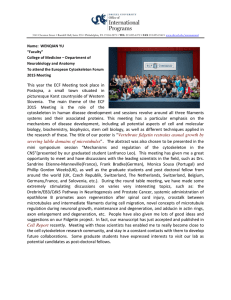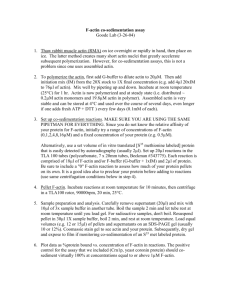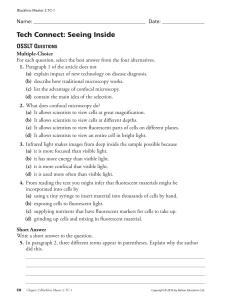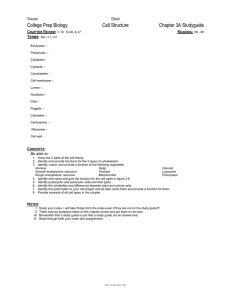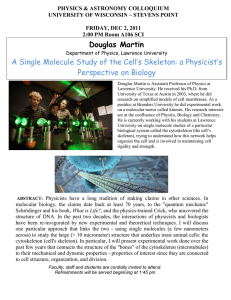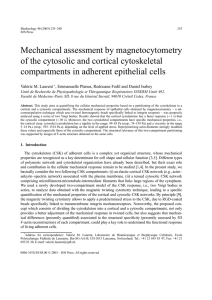Characterization of cytoskeleton mechanical properties and 3D-actin structure in twisted
advertisement
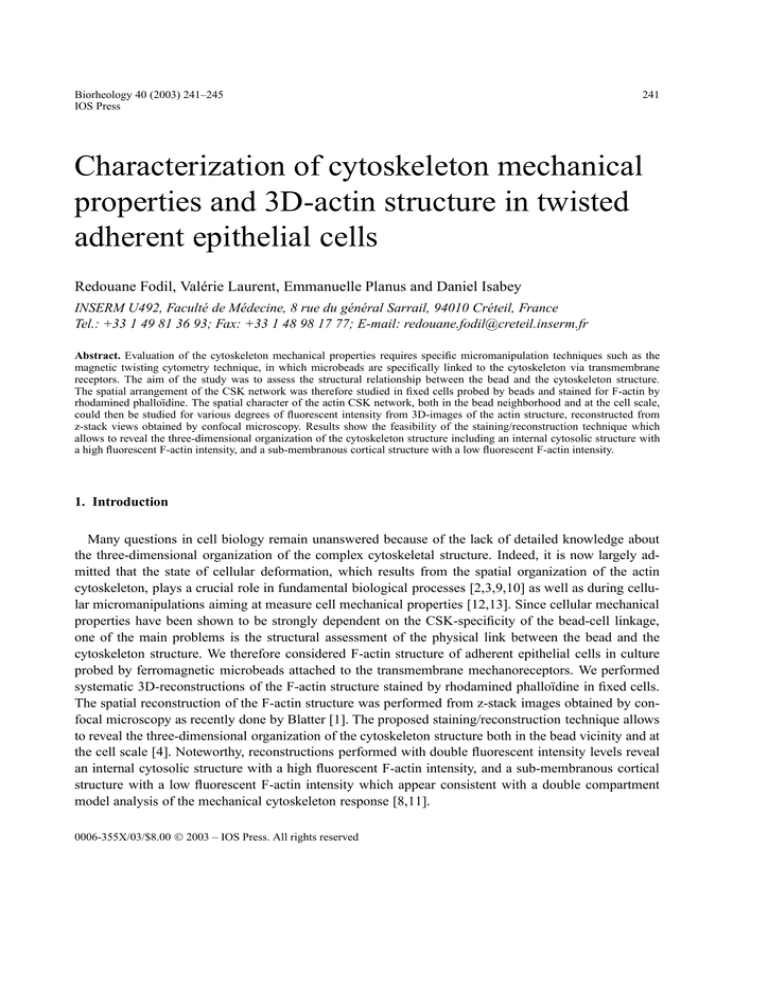
Biorheology 40 (2003) 241–245 IOS Press 241 Characterization of cytoskeleton mechanical properties and 3D-actin structure in twisted adherent epithelial cells Redouane Fodil, Valérie Laurent, Emmanuelle Planus and Daniel Isabey INSERM U492, Faculté de Médecine, 8 rue du général Sarrail, 94010 Créteil, France Tel.: +33 1 49 81 36 93; Fax: +33 1 48 98 17 77; E-mail: redouane.fodil@creteil.inserm.fr Abstract. Evaluation of the cytoskeleton mechanical properties requires specific micromanipulation techniques such as the magnetic twisting cytometry technique, in which microbeads are specifically linked to the cytoskeleton via transmembrane receptors. The aim of the study was to assess the structural relationship between the bead and the cytoskeleton structure. The spatial arrangement of the CSK network was therefore studied in fixed cells probed by beads and stained for F-actin by rhodamined phalloïdine. The spatial character of the actin CSK network, both in the bead neighborhood and at the cell scale, could then be studied for various degrees of fluorescent intensity from 3D-images of the actin structure, reconstructed from z-stack views obtained by confocal microscopy. Results show the feasibility of the staining/reconstruction technique which allows to reveal the three-dimensional organization of the cytoskeleton structure including an internal cytosolic structure with a high fluorescent F-actin intensity, and a sub-membranous cortical structure with a low fluorescent F-actin intensity. 1. Introduction Many questions in cell biology remain unanswered because of the lack of detailed knowledge about the three-dimensional organization of the complex cytoskeletal structure. Indeed, it is now largely admitted that the state of cellular deformation, which results from the spatial organization of the actin cytoskeleton, plays a crucial role in fundamental biological processes [2,3,9,10] as well as during cellular micromanipulations aiming at measure cell mechanical properties [12,13]. Since cellular mechanical properties have been shown to be strongly dependent on the CSK-specificity of the bead-cell linkage, one of the main problems is the structural assessment of the physical link between the bead and the cytoskeleton structure. We therefore considered F-actin structure of adherent epithelial cells in culture probed by ferromagnetic microbeads attached to the transmembrane mechanoreceptors. We performed systematic 3D-reconstructions of the F-actin structure stained by rhodamined phalloïdine in fixed cells. The spatial reconstruction of the F-actin structure was performed from z-stack images obtained by confocal microscopy as recently done by Blatter [1]. The proposed staining/reconstruction technique allows to reveal the three-dimensional organization of the cytoskeleton structure both in the bead vicinity and at the cell scale [4]. Noteworthy, reconstructions performed with double fluorescent intensity levels reveal an internal cytosolic structure with a high fluorescent F-actin intensity, and a sub-membranous cortical structure with a low fluorescent F-actin intensity which appear consistent with a double compartment model analysis of the mechanical cytoskeleton response [8,11]. 0006-355X/03/$8.00 2003 – IOS Press. All rights reserved 242 R. Fodil et al. / Cytoskeleton mechanical properties and 3D-actin structure 2. Material and methods 2.1. Bead attachment Carboxyl ferromagnetic beads (4.0–4.5 µm diameter, Spherotec Inc., IL, USA) were coated with arginine–glycin–aspartic acid (RGD) peptide following the company procedure (Telios Pharmaceutical Inc., CA, USA). Before used, coated-beads were incubated in serum free medium supplemented with 1% BSA for at least 30 minutes at 37◦ C to block non-specific binding. Beads were then added to the cells (40 µg per well) for 20 minutes at 37◦ C in 5% CO2 –95% air incubator. Unbound beads were washed away with serum free medium – 1% BSA supplemented with 25 mM HEPES. 2.2. Staining of fixed cells We stained the F-actin structure of human alveolar epithelial cell monolayer (A549 cell line) with fluorescent phallotoxin. Small plastic wells were fixed with silicone on round glass coverslides which were placed in Petri dishes and the inside surface of the wells (0.5 cm2 ) was coated with fibronectin at a concentration of 5 µg/cm2 . Cell monolayers with beads attached were rinsed twice with warm CSK-buffer (25 mM HEPES, 2 mM MgCl2 , 30 mM MES, 10 mM EGTA, 300 mM sucrose, pH 6.9) in order to maintain CSK integrity, as previously described. Cells were then fixed in 1% glutaraldehyde in CSK buffer for 15 minutes and incubated for 2 additional minutes with 0.5% Triton X100 and 0.25% glutaraldehyde in CSK-buffer at 37◦ C in order to permeabilized cells and then were rinsed twice with CSK-buffer. Rhodamined phalloïdin (0.76 µM) was dissolved in CSK-buffer and added to sample for 30 minutes in the dark and under humid chamber at room temperature. Cells were rinsed twice for 5 minutes with CSK-buffer, then a final rinse was performed with ddH2 0. The coverslides were mounted with 100 µl of mounting medium on top of the cell monolayer to keep the cell thickness intact. Samples were stored overnight at 4◦ C before examination by laser confocal. 2.3. Confocal microscopy Stained cell monolayers were observed using the LSM 410 invert confocal microscope (Zeiss, RueilMalmaison, France). The latter has two internal helium-neon laser and one external argon ion laser. Image processing was performed using LSM 410 software. Fields of cells were randomly selected, brought into focus using a ×63/1.4 numeric aperture Plan Neofluor objective. Epifluorescence was detected for a 543 nm excitation and 570 nm emission. A cross sectional image was recorded under confocal conditions and used to establish a plane of focus above the glass surface. Optical sections were recorded every 1 µm to reveal intracellular fluorescence. Apical localization of labelling was determined by obtaining vertical section. 2.4. 3D-reconstruction To undo the distortion due to the optical system of the confocal microscope, a 3D deconvolution process was performed on the stack of grey level images (8 bits) by the appropriate module of AxioVision 3.0.6 software (Carl Zeiss, NY, USA). The deconvolution process uses a mathematical algorithm which takes into account the theoretical function PSF (Point Spread Function) calculated for each acquisition parameters. The fixed images data are implemented at the right scale in Amira 2.2 software (TGS R. Fodil et al. / Cytoskeleton mechanical properties and 3D-actin structure 243 Fig. 1. Upper view (a) and vertical cross-section (b) views of three-dimensional reconstructions of fixed adherent epithelial cells probed by beads and stained for F-actin with rhodamine phalloïdine. The two fluorescent intensity levels used reveal an internal cytosolic structure with a high fluorescent F-actin intensity (dark grey), and an external cortical structure with a low fluorescent F-actin intensity (bright grey). Note that initial position of a given bead was spatially determined using spheres of appropriate sizes. Inc., CA, USA) which uses the threshold segmentation method to extract cell contours. Contours of external and internal sub-cellular structures corresponding to different levels of fluorescent intensity where defined using the curve of the “logarithmic” decrease in cumulated pixels of the stack images versus the gray level (0 to 255). The 3D-reconstruction was performed by a GMC module (Generalized Marching Cube algorithm) of Amira software which generates, using a triangulation method, an isosurface from segmented optical plans. Visualization of the 3D-reconstructed cells was performed using 3D-Studio Max v3.1 software (Kinetix, CA, USA), allowing calculation of volume from a surface, permitting by Boolean operations to generate vertical sections in the 3D-reconstructed cell. 3. Results and discussion Three-dimensional reconstruction of the cortical F-actin structure performed in fixed adherent epithelial cells probed by beads is presented in Fig. 1(a) (in bright grey). The threshold segmentation used for this reconstruction was about 5% of the full range of fluorescent intensity (0–255), a value which was given to represent the lowest F-actin density detectable. Although the F-actin was solely marked, it was possible to spatially determine the initial position of the beads using spheres whose sizes were precisely measured either under direct confocal microscopy or during post-acquisition from cell images stored in 244 R. Fodil et al. / Cytoskeleton mechanical properties and 3D-actin structure Interferential Contrast Nomarski. The degree of bead immersion in the cellular medium could also be determined by generating vertical sections with the reconstruction program (see Fig. 1(b)). Based on these 3D-reconstructions of external F-actin structure, the beads appear half immersed in the cellular medium. Indeed, degree of bead immersion is important to understand the twisting magnetic cytometry results as it happens to be a crucial parameter in the calculation of the elastic/viscous modulus [7]. Three-dimensional reconstruction of the internal F-actin structure is shown in Fig. 1(a) for the same cell. The threshold segmentation used for this reconstruction was about 36% of the full range of fluorescent intensity (0–255), an arbitrary value which was supposed to be sufficient to reveal the dense stress fiber structure. We present in Fig. 1(a), the 3D-reconstruction of the internal structure (in dark grey) which is embedded in the transparent external F-actin structure and which seems to determine the overall cell shape. It is also important to note that the dense structure concerns also the borders of the cell, meaning that the cell likely re-organizes its internal F-actin structure in addition to the local F-actin cortical structure surrounding the bead. This results reinforce the evidence of a mechanical continuum through the hierarchical CSK structure from the bead to low-density-F-actin then high-density-F-actin. In a recent study [8,11], it has been shown that the curve fitting analysis of the cellular response measured by twisting magnetic cytometry could be greatly improved by using a double compartment CSK model. The first compartment included a rapid (time constant <1 s), cortical CSK network embedding the bead, while the second compartment included a slow (time constant ∼30 s), cytosolic CSK, joining large regions of the cytoplasm, the behavior of each CSK compartments being represented by a simple Voigt model. Based on the double density CSK 3D-reconstruction study, we can postulate that the cortical CSK would represent the low F-actin density network while the cytosolic CSK would represent the denser F-actin network. Above all, the method presently proposed to reconstruct the CSK structure confirms early assumptions [5,6] about the physical linkage existing between coated beads and the cytoskeleton network and describes, through different levels of F-actin density, how this bead-CSK linkage occurs, both structurally and mechanically. In conclusion, the present results demonstrate the feasibility of the 3D-reconstruction in fixed cells stained for F-actin using adapted commercially available software and provide a general tool to study and quantify the structural linkage and remodeling of CSK structures. References [1] L.A. Blatter, Cell volume measurements by fluorescence confocal microscopy: theoretical and practical aspects, Methods in Enzymology 307 (1999), 274–295. [2] C.S. Chen, M. Mrksich, S. Huang, G.M. Whitesides and D.E. Ingber, Geometric control of cell life and death, Science 276(5317) (1997), 1425–1428. [3] M.E. Chicurel, C.S. Chen and D.E. Ingber, Cellular control lies in the balance of forces, Current Opinion in Cell Biology 10(2) (1998), 232–239. [4] R. Fodil, V. Laurent, S. Eddahibi, S. Wendling, E. Planus and D. Isabey, Parallel Assessment of the 3D-Actin Structure and Mechanical Properties of Cytoskeleton in Twisted Living Adherent Cells, Archives of Physiology and Biochemistry, Société de Biomécanique, Montreal, 108(1) (2000), 168. [5] D.E. Ingber, L. Dike, L. Hansen et al., Cellular tensegrity: exploring how mechanical changes in the cytoskeleton regulate cell growth, migration, and tissue pattern during morphogenesis, International Review of Cytology 150 (1994), 173–224. [6] D.E. Ingber, The riddle of morphogenesis: a question of solution chemistry or molecular cell engineering?, Cell 75(7) (1993), 1249–1252. [7] D. Isabey, V.M. Laurent, S. Hénon et al., Mechanical properties of adherent alveolar epithelial cells measured by bead micromanipulation: comparison of magnetic twisting cytometry vs optical tweezers, in: The FASEB Journal, Experimental Biology, Orlando, Florida, 15(4, Part I) (2001), A158. R. Fodil et al. / Cytoskeleton mechanical properties and 3D-actin structure 245 [8] V.M. Laurent, E. Planus, R. Fodil and D. Isabey, Mechanical assessment by magnetocytometry of the cytosolic and cortical cytoskeletal compartments in adherent epithelial cells, in: Euromech. Colloqium no. 420: Mechanobiology of Cells and Tissues, Nancy (France), 2001, Biorheology 40 (2003), 235–240. [9] A.J. Maniotis, C.S. Chen and D.E. Ingber, Demonstration of mechanical connections between integrins, cytoskeletal filaments, and nucleoplasm that stabilize nuclear structure, Proceedings of The National Academy of Sciences of The United States of America 94(3) (1997), 849–854. [10] D.J. Mooney, R. Langer and D.E. Ingber, Cytoskeletal filament assembly and the control of cell spreading and function by extracellular matrix, J. Cell Sci. 108(Pt 6) (1995), 2311–2320. [11] E. Planus, V.M. Laurent, R. Fodil, M.P. D’Ortho, A. Harf and D. Isabey, A double-compartment model of the cytoskeletal mechanical response of locally twisted alveolar epithelial cells: the effect of modulating environmental conditions, in: The FASEB Journal, Experimental Biology 2001, Orlando, Florida, 15(4, Part I) (2001), A159. [12] N. Wang, J.P. Butler and D.E. Ingber, Mechanotransduction across the cell surface and through the cytoskeleton, Science 260(5111) (1993), 1124–1127. [13] N. Wang and D.E. Ingber, Control of cytoskeletal mechanics by extracellular matrix, cell shape, and mechanical tension, Biophys. J. 66(6) (1994), 2181–2189.
